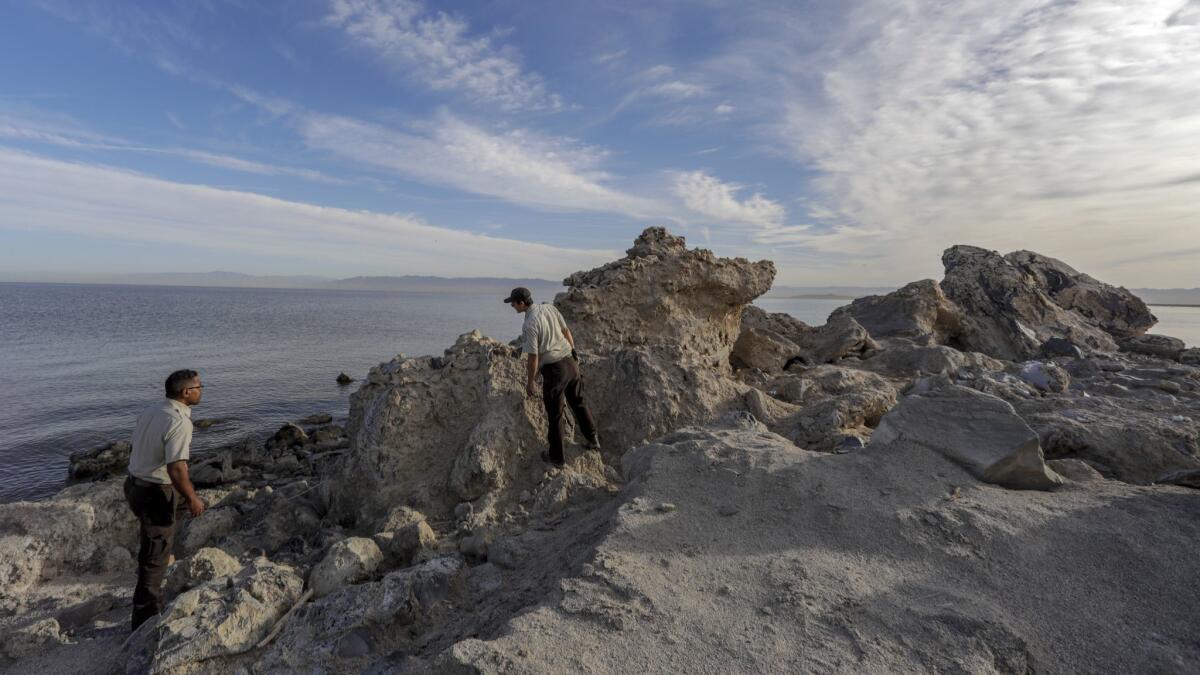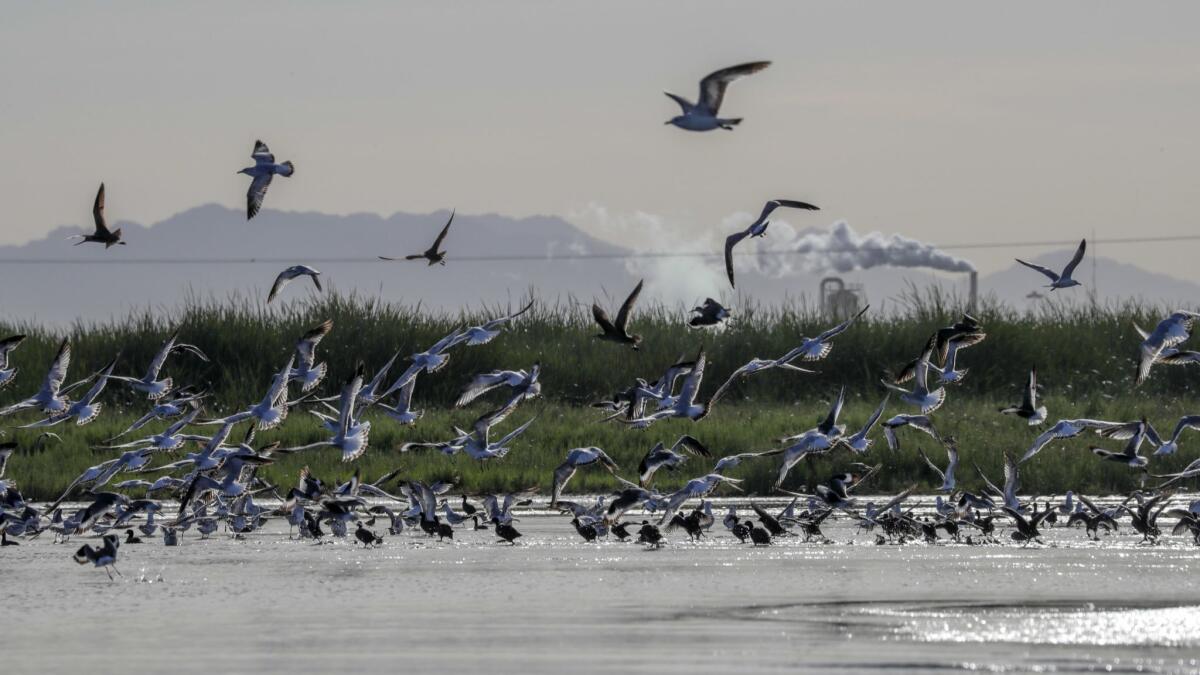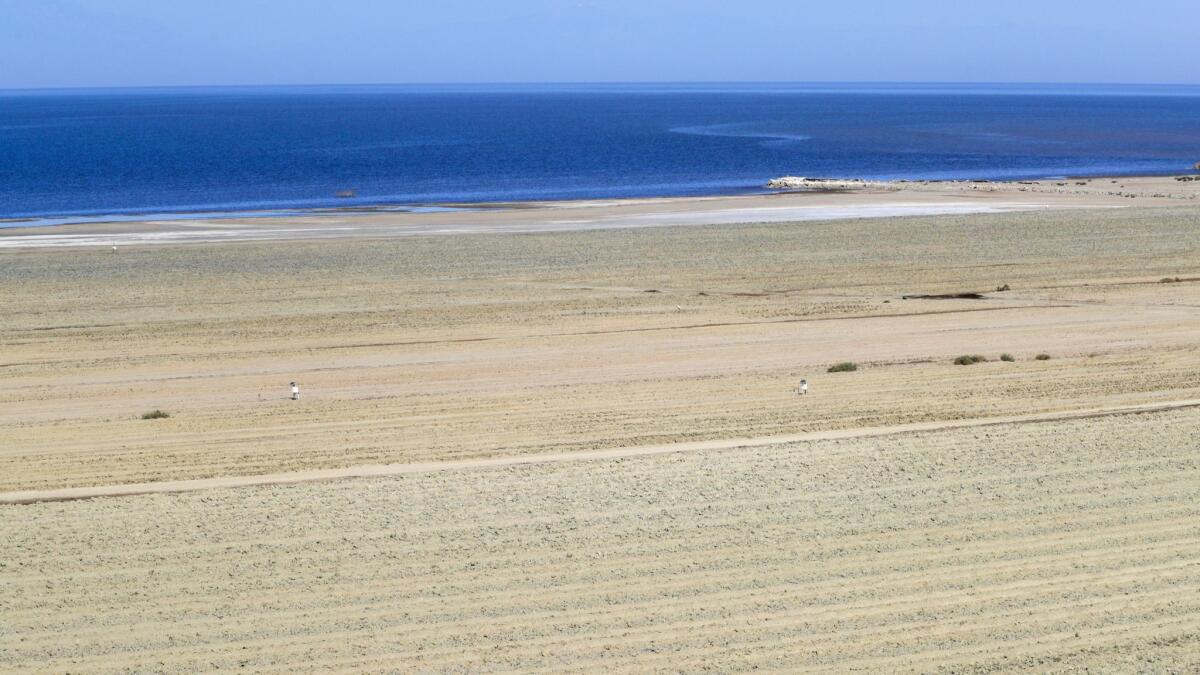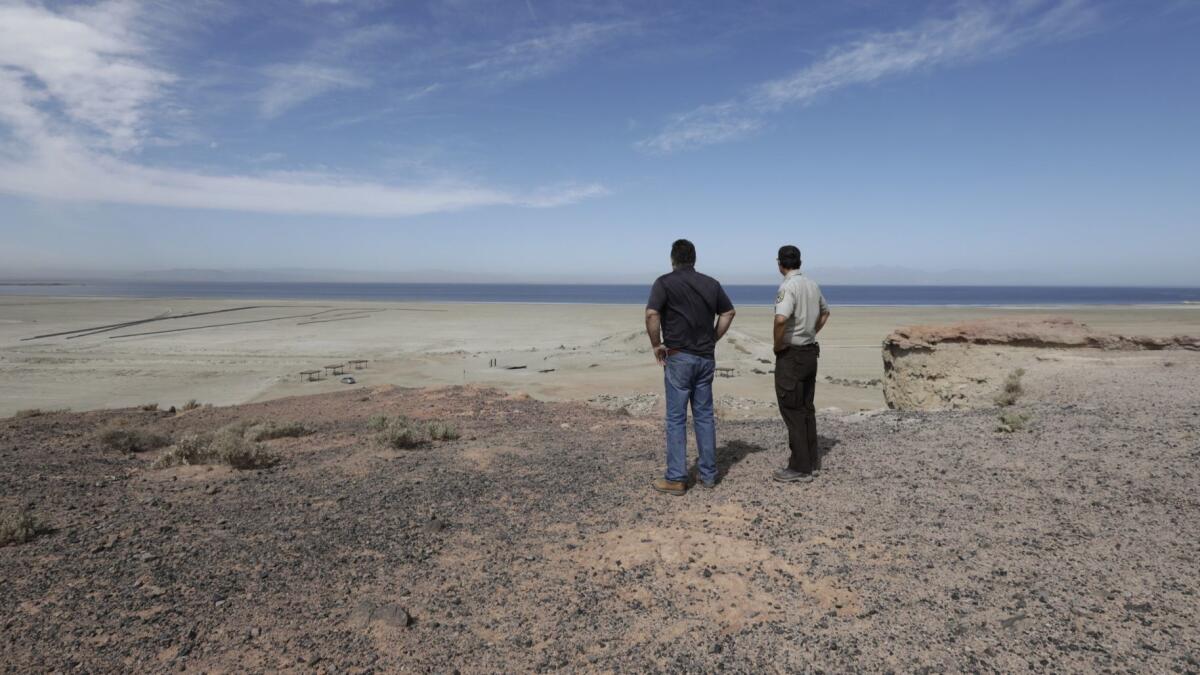As salinity grows and toxic dust spreads, patience wears thin at Salton Sea

- Share via
Reporting from Salton Sea National Wildlife Refuge — Assemblyman Eduardo Garcia watched with ill-disguised frustration as a hearing aimed at expediting state projects to restore habitat and control dust storms at the shrinking Salton Sea instead dissolved into discussion of why the efforts were falling further behind schedule.
“We have a plan, we have money, there is additional money lined up, and we have a constituency — myself included — that is running out of patience,” Garcia (D-Coachella), chairman of the Assembly Committee on Water, Parks and Wildlife, said.
Those banking on a revival of the Salton Sea have unfortunately grown familiar with waiting. After decades of environmental collapse, the state Legislature in 2017 approved a restoration plan estimated to cost more than $400 million. So far, $80.5 million has been approved, but delays are already mounting for initial projects designed to be showcases of restoration and dust mitigation.
Few dispute the need for prompt action: Scientists say clouds of salty, alkaline toxic dust containing heavy metals, agricultural chemicals and powdery-fine particulates linked to asthma, respiratory diseases and cancer are rolling off newly exposed playa, affecting the health of thousands of nearby residents.
But a thickening cloud of cynicism has extended among some locals over the ability of government agencies to complete Salton Sea restoration projects.
None of the officials in attendance at the meeting this month could say with certainty when state and local agencies would be on track to achieve benchmarks set years ago in the face of growing evidence of dangers lurking below, above and beyond the sea’s hypersaline waters.
A project to restore habitat on the southern end of the lake is running two years behind schedule. A separate effort touted as a “milestone dust suppression project” — beginning with 500 acres in 2018 and increasing to 4,200 acres by 2028 — has fallen behind schedule due to legal disagreements over needed permits, officials said.
“There is growing potential for an environmental justice lawsuit filed against responsible parties,” Luis Olmedo, who leads the Brawley-based nonprofit Comite Civico Del Valle, said. “They’re ignoring how these delays affect the health of the low-income, disadvantaged communities surrounding the Salton Sea.”
State officials attribute the delays to permitting requirements, complex federal environmental protection laws and haggling over engineering, contracts and funding.
Critics point to the Red Hill Bay project as an example of what has not been accomplished at California’s largest and most troubled lake.
The project was initially touted as an important part of the first phase of a 10-year restoration program. It would create more than 500 acres of shallow marine habitat at the sea’s southeastern end in Imperial County using water from a nearby river and a 183,000-pound steel barge equipped with pumps anchored a mile offshore.
Two years of delays have added $380,000 to the project’s $5.3-million budget. On top of that is the 25% tariff President Trump placed on imported steel in April from countries including China, which is expected to add at least $20,000, said Graeme Donaldson, Salton Sea program manager for the Imperial Irrigation District.
“The state of California will have to scrape up the additional costs,” said Bruce Wilcox, whom Gov. Jerry Brown appointed in 2015 as assistant secretary for Salton Sea policy at the California Natural Resources Agency. “I’m certain that the Red Hill project will be completed next year.”

That leaves that site and others targeted for restoration prone to choking dust storms, the wildlife to an uncertain future, and the assessment of responsibility for worsening air quality and environmental conditions to lawyers, government officials, regulatory authorities, conservationists, tribal leaders and community activists in neighboring Coachella and Imperial valleys.
The Salton Sea has become an environmental war zone, said Humberto Lugo, clean air advocate at Comite Civico del Valle, “where officials guard industries and agriculture, conservationists fight for birds and we’re struggling to minimize the impacts of worsening pollution on the area’s low-income communities.”
The Salton Sea was created in 1905 when the Colorado River broke through a silt-laden canal and roared unimpeded for two years into a basin near Brawley known as the Salton Sink. It grew into a 360-square-mile lake straddling Imperial and Riverside counties, about 150 miles southeast of Los Angeles.
Fishermen flocked to its barnacle-covered shores to catch corvina, croaker and sargo. Birds flocked to its wetlands, turning it into one of the most important stops along the Pacific Flyway, supporting 90% of the migration’s white pelicans.
But the Salton Sea is a non-draining body of water — which is what makes it a sea and not a lake — with no ability to cleanse itself. Trapped in its waters are salt and selenium-laden agricultural runoff from surrounding farms, as well as heavy metals and bacterial pollution that flow in from Mexico’s New River, authorities said.
Some scientists believe that 2018 will be the start of a profound environmental, public health and economic disaster for California.
The change was predicted in 2003 when the state Legislature promised to slow the shrinking of the lake as part of a successful effort to persuade the Imperial Irrigation District to sell some of its water to San Diego. Under the agreement, the water district stopped sending freshwater into the sea on Dec. 31, 2017.
“The transition is underway,” Timothy Bradley, a professor of ecology at UC Irvine and expert on the Salton Sea, said. “The Salton Sea of the future will resemble Mono Lake in California’s Sierra range and the Great Salt Lake in Utah, which support limited ecological diversity but lots of shorebirds, brine shrimp and brine flies.
“I worry that state and federal officials will not respond with the urgency called for in this situation,” Bradley said, “until people lose their lives because of it.”
Critics say that with the exception of proposing a handful of dust suppression and habitat restoration projects, including Red Hill Bay, the state has failed to follow through on its promise.

Meanwhile, diversion of freshwater inflows is causing water in the lake to recede at a rate of about a foot each year, officials said. Falling lake levels are connecting islands to the mainland, allowing coyotes to raid nesting grounds.
In 2010, salinity levels in the Salton Sea were about 50 parts per thousand parts of water, federal reclamation authorities said. Today, they are above 60 parts per thousand and rising. By comparison, the salinity level of the Pacific Ocean is about 35 parts per thousand.
Most species of fish in the Salton Sea have died off, and immense populations of pelicans, cormorants and eared grebes have dwindled in places such as the Sonny Bono Salton Sea National Wildlife Refuge at the southern end of the 35-mile-long lake.
The only fish in the Salton Sea today are inch-long desert pupfish and hybrid tilapia. Scientists say they will only exist near the mouths of rivers and canals once the salinity level reaches 70 parts per thousand sometime within the next five years.
A study by the U.S. Bureau of Reclamation argued that doing nothing to keep the Salton Sea viable could end up costing nearly $10 billion.

But the growing danger signs have sped up efforts to apply measures untested here but proved useful elsewhere, such as dusty Owens Lake, which was drained by the completed Los Angeles Aqueduct in 1913.
The Imperial Irrigation District is experimenting with a relatively inexpensive solution on salt flats near Red Hill Bay. It involves using tractors to turn playas into furrows and clods of dirt. The clods will bottle up the dust for years before breaking down, at which point the process will be repeated.
Riverside County Supervisor Manuel Perez this year unveiled a possible $400-million in-lake barrier, or dam, that would allow the north end of the lake to be filled with enhanced flows from the Whitewater River to create what he described as “a 4,200-acre healthy lake within a much larger not-so-healthy one.”
But community activists aren’t content waiting for such projects to come on line.
The Comite Civico Del Valle oversees 40 community-based air quality monitors recently installed in selected locations across Imperial Valley. “The readings generated by these monitors,” Lugo said, “have enabled us to sound the alarm when air pollution is excessive, reducing exposure in dozens of local schools and neighborhoods.”
That information, he added, may one day be combined with data collected from ongoing scientific analyses of air, water and soil samples by research teams from universities including UC Irvine, UC Riverside, UC Davis and USC to support an environmental justice suit.

On a recent weekday, Frank Ruiz, a police chaplain and the Audubon Society’s Salton Sea program director, surveyed the murky waves rolling up on a stretch of beach tinged with the stench of rotten eggs.
“I used to think the environmental catastrophe unfolding here would move the needle,” he said. “But it didn’t. Then I thought, surely the threat to human health will save this lake. It didn’t.
“Now, I believe not much is going to happen until the problems hit peoples’ pocketbooks and real estate values,” he added. “But even then, it will take a lot of compromising, which isn’t easy around here.”
Twitter: @LouisSahagun
More to Read
Sign up for Essential California
The most important California stories and recommendations in your inbox every morning.
You may occasionally receive promotional content from the Los Angeles Times.










